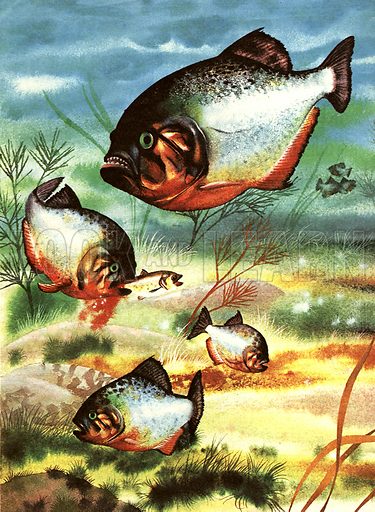
|
For more articles like this go to the Look and Learn articles website. |

Possibly the most feared freshwater fish is the piranha. It is often featured in films and television plays, particularly when the scriptwriters want to dispose of a body or invent a form of torture! And many, many are the tales which travellers and explorers have told about this fearsome fish.
The piranha, or piraya as it is called by the inhabitants of the part of the world where it is found, lives in and around the Amazon Basin in South America, in the Amazon and Orinoco rivers and their many tributaries. It is a member of the family of fishes known as the characins (usually pronounced “karasin”) among which are quite a number of species known as piranha. Some are less ferocious than others.
The piranha is not quite as formidable to look at as might be expected. It grows to only about 25 cm in length and has quite a small mouth with just a few rows of very fine needle-like teeth.
The secret of the hunting piranha’s success lies in its method of attack. It always hunts in tightly packed shoals, and preys upon almost any animal life that swims or falls into the water.
Of course fish and a few water birds, etc., are its natural prey, but there are well-founded tales of its attacking larger animals such as horses, and even humans. Eyewitnesses claim to have seen horses reduced to skeletons in a matter of a few minutes. Also, quite a number of native canoes have been overturned in these rivers, and the occupants lost for ever. Many other natives carry piranha scars.
Piranha are very popular with aquarists. Although usually only one specimen is kept in a fairly large tank, they always prove a talking point in the home and a great attraction at exhibitions. The most popular variety has a reddish colouring on the underside and grows to a length of 15 cm.
Aquarists usually buy the fish when it is quite small (about 30 millimetres long) and then train it to live on a meat diet.
One public aquarium in Germany has been successful in breeding piranha and has even raised several hundred of the young ones. But one German keeper carries a scar which proves that even a popular hobby such as tropical fishkeeping can have its problems!